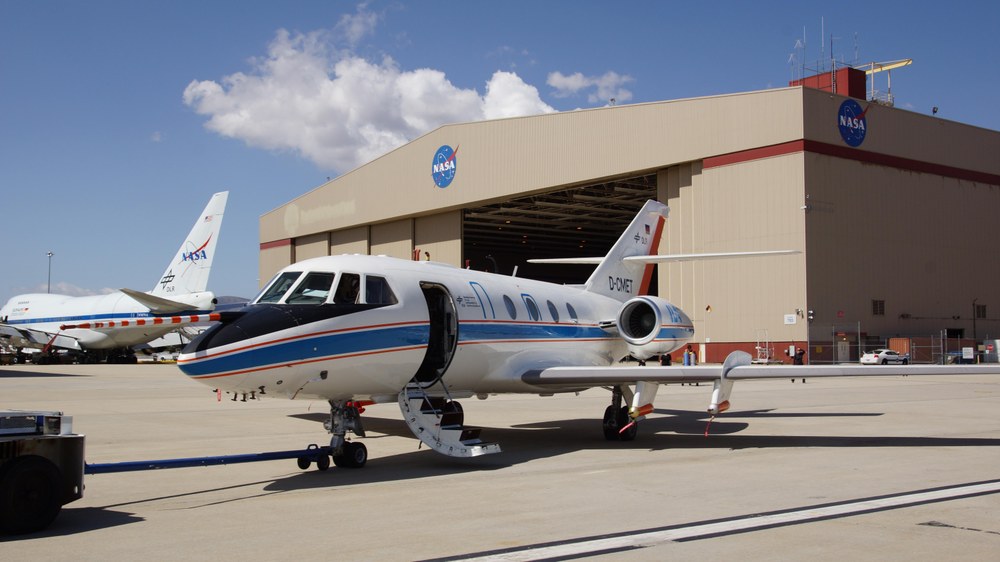Biofuels reduce soot emissions from aircraft

- Biofuel reduces soot particle emissions during cruising
- Reducing the emissions of soot particles reduces the climatic impact of contrails
- Results of joint DLR / NASA research flights, which were conducted in California in May 2014, published in the scientific journal Nature
A fuel blend with 50 percent biofuel reduces soot particle emissions of the aircraft by 50 to 70 percent compared to conventional fuel, according to a study published in the scientific journal Nature. The findings are based on an international flight experiment between NASA, the German Aerospace Center (Deutsches Zentrum für Luft- und Raumfahrt; DLR) and the National Research Council (NRC) of Canada. The results provide important information on how the use of biofuels in aviation can contribute to making air transport more environmentally friendly – not only by reducing emissions in the vicinity of airports, but also at cruise conditions.
Impact of contrail cirrus clouds on climate
Aircraft engines emit soot particles. These serve as condensation nuclei for small droplets and ice crystals, driving the formation of contrails. The ice crystals of the contrails can remain for several hours in cold and humid conditions at altitudes of between 8 to 12 kilometres, and form high clouds known as contrail cirrus. "Contrail cirrus clouds have a similar impact on the climate than all aviation carbon dioxide emissions that have accumulated over more than 100 years in the atmosphere," says the co-author of the Nature publication Hans Schlager from the DLR Institute of Atmospheric Physics. "The soot emissions largely determine the number of ice crystals in contrails. The possibility of reducing the engine exhaust soot emissions by more than half using biofuels paves the way for reducing the climatic impact of contrails," continues Schlager.
Measurements in the exhaust plume

embeddedvideo0
Your consent to the storage of data ('cookies') is required for the playback of this video on Youtube.com. You can view and change your current data storage settings at any time under privacy.
In May 2014, the DLR research aircraft Falcon took to the air, equipped with state-of-the-art instrumentation and operated by a crew of specialists from the DLR Institute of Atmospheric Physics and DLR Flight Operations in the United States. They followed the NASA DC-8 research aircraft at close distances ranging from 30 to 150 metres to measure exhaust composition from each of the inboard engines. The DC-8's CFM56 engines were alternately powered by normal Jet A1 fuel and a 1:1 blend of Jet A1 fuel with the biofuel of hydroprocessed esters and fatty acids (HEFA). HEFA is produced from Camelina plant oil.
Previous measurements had only provided information on soot formation using biofuels on the ground, whereas different environmental conditions prevail in flight. "This is the first time we have quantified the amount of soot particles emitted by jet engines while burning biofuel-blended fuel in flight," said Rich Moore, NASA scientist and lead author of the Nature article. The tests were conducted as part of the Alternative Fuel Effects on Contrails and Cruise Emissions Study (ACCESS) at NASA Armstrong Flight Research Center in Palmdale, California. DLR was invited to participate in the research project by NASA. The DLR Falcon 20E, together with NASA’s Falcon HU-25C measuring aircraft and the T-33 of the Canadian NRC, measured the emissions of the preceding DC-8.
Experienced crew and proven measuring equipment
More than a dozen instruments mounted on the trailing aircraft characterised the exhaust particles and gases emitted by the engines of the preceding DC-8. "Measurements in the wake of aircraft require highly experienced crewmembers and proven measuring equipment, which DLR has built up over many years," says Schlager. "Since 2000, the DLR Falcon has been used in numerous measurement campaigns to investigate the emissions and contrails of commercial airliners."
Successful cooperation
DLR and NASA have been cooperating in the field of atmospheric research for 18 years. In aeronautics research, both partners are particularly involved in joint research projects in the areas of air traffic management, as well as low-noise and low-emission flying. The joint research flights in May 2014 were a highlight of this longstanding cooperation. In the future, close cooperation is also planned in the investigation of biofuel emissions. In early 2018, NASA will participate with the DC-8 in a series of research flights in Germany conducted as part of DLR's own project, ECLIF (Emission and Climate Impact of alternative Fuel). Here, the researchers want to more closely investigate how the composition of different alternative fuels influences the emissions and the climate-relevant properties of contrails.


